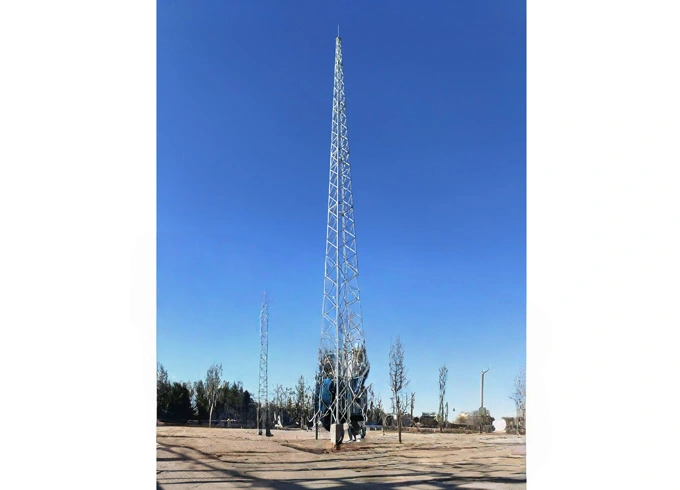Lightning can destroy essential communication systems in seconds. It causes downtime, equipment loss, and safety hazards. That’s why strong lightning protection is not optional—it’s critical.
The cell tower lightning protection prevents costly damage, protects equipment, and ensures uninterrupted mobile service by grounding lightning strikes and dissipating electrical surges.
When I first started learning about telecom structures, I didn’t think much about lightning. But then I heard about a site that went offline for hours—just from one strike. That’s when I realized how vital protection systems are. If your tower isn’t protected, it’s vulnerable. Let's look at why and how to solve it.

Even a single lightning strike can shut down mobile networks. The damage goes beyond physical—it affects communication, safety, and revenue.
Lightning strikes cause fire hazards, damage to antennas and cables, data loss, and network outages. That’s why cell towers need reliable grounding and surge protection systems.
Lightning hits cell towers because they are tall and often isolated. A direct strike can melt wires, fry electronics, and start fires. It can also spread through the network, damaging connected systems. That’s why I always recommend combining several protection measures: lightning rods, surge arresters, and solid grounding. Below is a breakdown of their key functions.
| Risk Type | Description |
|---|---|
| Equipment Damage | Antennas, feeders, and base stations can burn or stop working. |
| Signal Disruption | Services like calls, GPS, and data get interrupted. |
| Safety Hazards | Risk of fire or electric shock to maintenance personnel. |
| Financial Loss | Cost of repairs, replacements, and service interruptions. |
| Data Corruption | Network logs, configurations, and performance data may be lost. |
There’s no one-size-fits-all solution. The right system depends on your tower’s structure, height, location, and nearby risks.
Choose a system based on tower design, grounding soil resistance, and potential exposure to lightning frequency. Combine air terminals, surge protectors, and low-resistance grounding.
I remember a project where we had to protect a tower on a hilltop. The location was beautiful but also a lightning magnet. We used a ring grounding system with copper rods and added Class I surge protectors. We reduced strike damage by 90% after that. To help others choose, here’s a simplified comparison.

| Component | Purpose | Best Use Case |
|---|---|---|
| Air Terminal (Rod) | Attracts lightning strike to a controlled point | All tower types |
| Down Conductor | Transfers energy from rod to the ground safely | Steel or copper wire preferred |
| Grounding System | Dissipates current into the earth | Soft, moist soil areas recommended |
| Surge Protection Device | Protects electronic devices from voltage spikes | Installed on power/data lines |
Even the best system fails if it’s installed poorly or not maintained. Lightning protection requires care and regular checks.
Proper installation means correct placement of rods, secure grounding, and no corrosion. Annual inspections help detect faults early and keep the system effective.
At Junjiang, we once inspected a tower where the grounding rod had corroded completely. The system was installed years ago and never checked. We replaced the components and added zinc coating for durability. Since then, that site hasn't had a single issue. Below is a basic checklist I follow on all jobs.
Use corrosion-resistant materials (copper or galvanized steel)
Ensure grounding resistance is <10 ohms (ideally <5 ohms)
Place rods at the highest exposed points
Tighten all connections, especially at junctions
Inspect visually every 6 months; test resistance annually
Replace damaged SPD devices immediately
New technologies make lightning protection smarter, faster, and more reliable. These systems adapt to weather and monitor their own health.
Advanced systems include intelligent surge protectors, grounding monitors, and early streamer emission (ESE) terminals for proactive defense.
I’ve seen smart SPD devices that alert the network when they’ve absorbed a surge and need replacement. There are even sensors that monitor soil resistance over time. These innovations help reduce downtime and maintenance costs. If you’re upgrading or building new towers, it’s worth considering these features. Junjiang steel tower factory offers hightech lighting tower for your need.
| Technology | Benefit | Notes |
|---|---|---|
| Smart Surge Protectors | Notify team of failure or saturation | Ideal for remote towers |
| Grounding Monitors | Tracks real-time soil resistance | Helps prevent future failures |
| ESE Terminals | Attract strikes earlier, directing them safely | Suitable for high-risk lightning zones |
| Modular Grounding Kits | Easy to install and replace | Speeds up field work |
Strong lightning protection keeps cell towers safe and networks running. The right design, routine care, and modern tech make all the difference.
